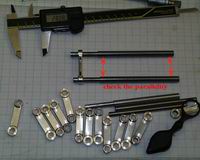
A few numbers to give you an idea what kind of fits and plays
I think are right:
• crankshaft at room temperature: axial play .04 - .08 mm with the propeller
tightened. If you don't feel any play when the engine has just run and is back
at a temperature between 20 and 30 degr. Celsius or you measure less play (bearings
free from castor oil!), send the engine back. When you take the engine apart,
take care that the shims that are behind the front bearing don’t get lost.
These shims are individual for every engine and take care that the outer rings
of the bearings have exactly the right position relative to the shaft. See also
chapter 5.
• Connecting rod big-end radial play .035 -.050 mm, small end-play .025
- .045 mm. If the play is more, replace the connecting rod. Too much play can
lead to a sudden self-destruction of the rod, usually by the big-end side opening
up. (Just before that moment your engine will be faster than it ever was).
• The wear (or better, the deformation) of the aluminium/bronze connecting
rod big-end depends highly on its temperature. The crankshaft design is such
that a lot of fuel and air directly hit this part. Whatever you change to the
engine, be aware that connecting rod cooling is crucial!
• The big-end axial connecting rod play should be in the order of .1 -
.25 mm, but is not very critical.
• It is useful to check the parallelity of the connecting rod holes after
some 50 flights, if you are able to. It should be better than .05 mm/100mm.
Click on picture to enlarge
Piston pin in piston 0.000-.010 mm radial play, which means "no visible" play. If there is more play, send the piston and cylinder back for fitting a new piston. The reason for using blind hole in the piston and a 6 mm piston pin in the MBPROFI, is however to minimise problems of piston-pin play, which is caused by deformation of the piston from high thermal an mechanical loads. So: keep the piston cool (see: running the engine) to maximise piston life.